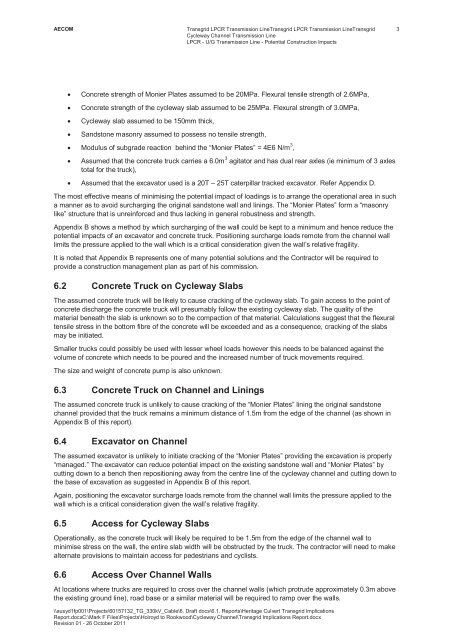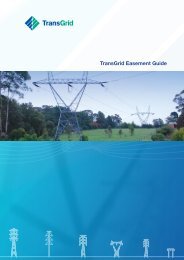Holroyd to Rookwood Road cable REF - TransGrid
Holroyd to Rookwood Road cable REF - TransGrid
Holroyd to Rookwood Road cable REF - TransGrid
You also want an ePaper? Increase the reach of your titles
YUMPU automatically turns print PDFs into web optimized ePapers that Google loves.
AECOM Transgrid LPCR Transmission LineTransgrid LPCR Transmission LineTransgrid<br />
Cycleway Channel Transmission Line<br />
LPCR - U/G Transmission Line - Potential Construction Impacts<br />
Concrete strength of Monier Plates assumed <strong>to</strong> be 20MPa. Flexural tensile strength of 2.6MPa,<br />
Concrete strength of the cycleway slab assumed <strong>to</strong> be 25MPa. Flexural strength of 3.0MPa,<br />
Cycleway slab assumed <strong>to</strong> be 150mm thick,<br />
Sands<strong>to</strong>ne masonry assumed <strong>to</strong> possess no tensile strength,<br />
Modulus of subgrade reaction behind the “Monier Plates” = 4E6 N/m 3 ,<br />
Assumed that the concrete truck carries a 6.0m 3 agita<strong>to</strong>r and has dual rear axles (ie minimum of 3 axles<br />
<strong>to</strong>tal for the truck),<br />
Assumed that the excava<strong>to</strong>r used is a 20T – 25T caterpillar tracked excava<strong>to</strong>r. Refer Appendix D.<br />
The most effective means of minimising the potential impact of loadings is <strong>to</strong> arrange the operational area in such<br />
a manner as <strong>to</strong> avoid surcharging the original sands<strong>to</strong>ne wall and linings. The “Monier Plates” form a “masonry<br />
like” structure that is unreinforced and thus lacking in general robustness and strength.<br />
Appendix B shows a method by which surcharging of the wall could be kept <strong>to</strong> a minimum and hence reduce the<br />
potential impacts of an excava<strong>to</strong>r and concrete truck. Positioning surcharge loads remote from the channel wall<br />
limits the pressure applied <strong>to</strong> the wall which is a critical consideration given the wall’s relative fragility.<br />
It is noted that Appendix B represents one of many potential solutions and the Contrac<strong>to</strong>r will be required <strong>to</strong><br />
provide a construction management plan as part of his commission.<br />
6.2 Concrete Truck on Cycleway Slabs<br />
The assumed concrete truck will be likely <strong>to</strong> cause cracking of the cycleway slab. To gain access <strong>to</strong> the point of<br />
concrete discharge the concrete truck will presumably follow the existing cycleway slab. The quality of the<br />
material beneath the slab is unknown so <strong>to</strong> the compaction of that material. Calculations suggest that the flexural<br />
tensile stress in the bot<strong>to</strong>m fibre of the concrete will be exceeded and as a consequence, cracking of the slabs<br />
may be initiated.<br />
Smaller trucks could possibly be used with lesser wheel loads however this needs <strong>to</strong> be balanced against the<br />
volume of concrete which needs <strong>to</strong> be poured and the increased number of truck movements required.<br />
The size and weight of concrete pump is also unknown.<br />
6.3 Concrete Truck on Channel and Linings<br />
The assumed concrete truck is unlikely <strong>to</strong> cause cracking of the “Monier Plates” lining the original sands<strong>to</strong>ne<br />
channel provided that the truck remains a minimum distance of 1.5m from the edge of the channel (as shown in<br />
Appendix B of this report).<br />
6.4 Excava<strong>to</strong>r on Channel<br />
The assumed excava<strong>to</strong>r is unlikely <strong>to</strong> initiate cracking of the “Monier Plates” providing the excavation is properly<br />
“managed.” The excava<strong>to</strong>r can reduce potential impact on the existing sands<strong>to</strong>ne wall and “Monier Plates” by<br />
cutting down <strong>to</strong> a bench then repositioning away from the centre line of the cycleway channel and cutting down <strong>to</strong><br />
the base of excavation as suggested in Appendix B of this report.<br />
Again, positioning the excava<strong>to</strong>r surcharge loads remote from the channel wall limits the pressure applied <strong>to</strong> the<br />
wall which is a critical consideration given the wall’s relative fragility.<br />
6.5 Access for Cycleway Slabs<br />
Operationally, as the concrete truck will likely be required <strong>to</strong> be 1.5m from the edge of the channel wall <strong>to</strong><br />
minimise stress on the wall, the entire slab width will be obstructed by the truck. The contrac<strong>to</strong>r will need <strong>to</strong> make<br />
alternate provisions <strong>to</strong> maintain access for pedestrians and cyclists.<br />
6.6 Access Over Channel Walls<br />
At locations where trucks are required <strong>to</strong> cross over the channel walls (which protrude approximately 0.3m above<br />
the existing ground line), road base or a similar material will be required <strong>to</strong> ramp over the walls.<br />
\\ausyd1fp001\Projects\60157132_TG_330kV_Cable\6. Draft docs\6.1. Reports\Heritage Culvert Transgrid Implications<br />
Report.docxC:\Mark F Files\Projects\<strong>Holroyd</strong> <strong>to</strong> <strong>Rookwood</strong>\Cycleway Channel\Transgrid Implications Report.docx<br />
Revision 01 - 26 Oc<strong>to</strong>ber 2011<br />
3




